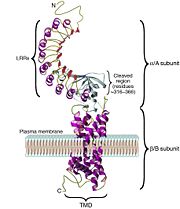Sandbox 27
From Proteopedia
TSH Receptor in complex with the thyroid-stimulating autoantibody M22
PLEASE do NOT change this sandbox. It is currently reserved by Nathalie F, for use by Proteopedia Project, ESBS Strasbourg
The thyrotropin receptor (or TSH receptor or TSHR) is a member of the G protein-coupled receptor superfamily of integral membrane proteins and is coupled to the Gs protein. It is on the surface of thyroid follicular cells. Once stimulated by TSH (Thyroid-Stimulating Hormone), THSR activates the production of thyroid hormones: thyroxine (T4) and triiodothyronine (T3).
TSH and M22
TSH is a hormone also known as "thyrotropin". It is a member of the Glycoprotein Hormone Family or GHF(like LH, FSH or hCG). TSH regulates the growth and the function of thyroid follicular cells by stimulating the secretion of thyroid hormones T3 and T4. These hormones play an important role in human reproduction, metabolism and cellular development. Therefore, this class of receptors is central to medical, pharmaceutical, and biological research.
The studies on the structure of TShttp://proteopedia.org/wiki/skins/common/images/button_bold.pngH receptor are based upon its binding to an antibody called M22. Crystals suitable for X-Ray diffraction analysis were obtained and the structure solved at 2.55 A resolution. Further crystallographic information is available from Pubmed
M22 is a thyroid stimulating human monoclonal antibody prepared using lymphocytes from a patient with Graves’ disease. It is an antibody to the TSHR. It mimics closely the binding of TSH on its receptor, so it stimulates the receptor and inhibits the binding of TSH to give rise to full activation of receptor mediated signal transduction.
Signalling pathway
TSH hormone or in our case the autoantibody M22 binds to its receptor (more precisely to the LRD). This binding actives the receptor and then small G-proteins coupled to the receptor. The alpha subunit stimulates enzymes of the cellular membrane. A cascade of reactions and second messengers pathways are involved and result in the stimulation and the synthesis of thyroid hormones T3 and T4.
Structure of the TSH Receptor
This receptor is evolutionary classified as rhodopsin-like receptors of family A. It is consisted of five different domains:
- An extracellular domain or ectodomain: it consists of ten leucine-rich repeats, so also called leucine rich domain or LRD, or LRRs. This ectodomain forms a concave surface (also with some contribution from the CD), it is responsible for the high affinity and selective binding of the corresponding hormones.
- A N-Terminal tail : it contains four half-cystines linked by disulfide bonds to the first of ten repeats of the LRD.
- A cleavage domain (or CD, or CR for cleaved region): it contains six half-cystines and it is cleaved out upon maturation in the case of the TSHR.
- A transmembrane domain (also called "serpentine" or TMD): it contains seven helixes connected by three extra- and three intracellular loops (ECL1-3; ICL1-3)
- A C-terminal intracellular domain.
Full information about the LRD domain from Hot Thyroidology Journal
Here is a scheme of the THS bound to its receptor TSRH:
One of models for the receptor’s activation explains that interactions between ectodomain and extracellular loops would inhibit the activity of serpentine domain in the absence of stimulation. But when THS is binding to LRD, the ectodomain would have a change of conformation which activates the transduction of the signal. [1]

